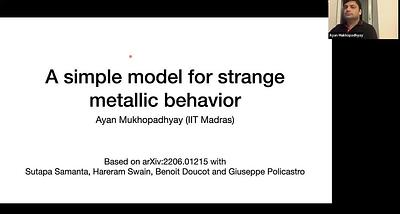By: Sutapa Samanta, Hareram Swain, Benoît Douçot, Giuseppe Policastro, Ayan Mukhopadhyay
We show how strange metallic behavior emerges from a simple effective semi-holographic theory with only two couplings. This model is justified by the Wilsonian RG approach but ignores order parameters, and describes carrier electrons interacting with a critical sector with only two effective dimensionless couplings. We establish that this model has an emergent universal spectral function near the Fermi surface at an optimal ratio of the two e... more
We show how strange metallic behavior emerges from a simple effective semi-holographic theory with only two couplings. This model is justified by the Wilsonian RG approach but ignores order parameters, and describes carrier electrons interacting with a critical sector with only two effective dimensionless couplings. We establish that this model has an emergent universal spectral function near the Fermi surface at an optimal ratio of the two effective couplings when the critical exponent ν lies between 0.66 and 0.95 for a wide range of temperatures which could be as low as 1 percent of the Fermi energy when ν is at the higher end. The linear in T resistivity and quadratic in T Hall resistivity (the latter for a spherical Fermi surface) follow from the universality of the spectral function for a wide range of temperatures in which the relevant loop integrals get contributions mainly from momenta near the Fermi surface. Our spectral functions fit very well with data from ARPES experiments for optimal, over and under-doping with a fixed exponent over a range of temperatures, validating universality at optimal doping. We obtain a refined Planckian dissipation picture where the scattering time τ≈f⋅ℏ/(kBT) with f almost independent of all model parameters except for the overall strength of the two couplings when their ratio is optimal. We find f≈1 when the couplings take maximal value for which strange metallic behavior is exhibited. However, f≈10 when the couplings are smaller. Although not derivable from quasi-particles, our results at optimal doping fit a Drude-type phenomenology with Planckian scattering time, and an almost model-independent n/m, which is about 2π times the Fermi liquid value at same EF. less
Introduction to ScienceCast
5upvotes
By: Nicole Morgan of McKinsey Quantum on behalf of the Scientific Board of ScienceCast
Welcome to ScienceCast - a universal ecosystem for research, publishing, and exchange of scientific ideas using 21st century tools. ScienceCast was founded by a group of scientists and experts in academic publishing in response to a major problem facing modern day science - exponential proliferation of scientific data. The problem is not handling the big data, but extracting gems and useful insights from the avalanche of scientific papers. J... more
Welcome to ScienceCast - a universal ecosystem for research, publishing, and exchange of scientific ideas using 21st century tools. ScienceCast was founded by a group of scientists and experts in academic publishing in response to a major problem facing modern day science - exponential proliferation of scientific data. The problem is not handling the big data, but extracting gems and useful insights from the avalanche of scientific papers. Just 20 years ago, it was possible for researchers to follow all developments in their discipline, but information overload makes the traditional modes of research dissemination no longer sustainable. To partially overcome this challenge, ScienceCast introduces a new model, whose key component is a stream of short video pitches summarizing a scientific discovery with links to the full-length articles & data. It also provides space for professional research discussion and continuous peer feedback. The scientific content is reviewed by a professional scientific board and select contributions will be disseminated broadly to the relevant communities, journal editors, funding agencies, and the public. To submit a contribution simply record a short 3-5 minute video on your research (using zoom or a built-in screen recording functionality, e.g. Shift-Command-5 on Mac), go over your manuscript or 2-3 slides highlighting the main results of your work, and provide a link to the full-text of your paper for more details. less

